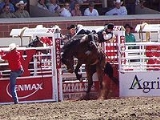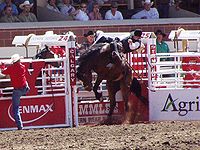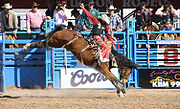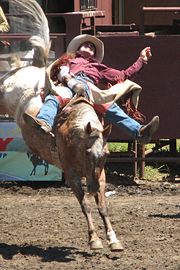
Bronc riding
Encyclopedia

Rodeo
Rodeo is a competitive sport which arose out of the working practices of cattle herding in Spain, Mexico, and later the United States, Canada, South America and Australia. It was based on the skills required of the working vaqueros and later, cowboys, in what today is the western United States,...
event that involves a rodeo participant riding on a horse
Horse
The horse is one of two extant subspecies of Equus ferus, or the wild horse. It is a single-hooved mammal belonging to the taxonomic family Equidae. The horse has evolved over the past 45 to 55 million years from a small multi-toed creature into the large, single-toed animal of today...
(sometimes called a bronc or bronco
Bronco
Bronco, or bronc is a term used in the United States, northern Mexico and Canada to refer to an untrained horse or one that habitually bucks. It may refer to a feral horse that has lived in the wild its entire life, but is also used to refer to domestic horses not yet fully trained to saddle, and...
), that attempts to throw or buck off
Bucking
Bucking is a movement performed by a horse or bull in which the animal lowers his head and raises his hindquarters into the air, usually while kicking out with his hind legs. If powerful, it may unseat the rider enough so that he falls off....
the rider. Originally based on the necessary horse breaking skills of a working cowboy, the event is now a highly stylized competition that utilizes horses that often are specially bred for strength, agility, and bucking ability. The event has provoked concerns among some animal welfare
Animal welfare
Animal welfare is the physical and psychological well-being of animals.The term animal welfare can also mean human concern for animal welfare or a position in a debate on animal ethics and animal rights...
advocates that some of the practices used in the event may constitute animal cruelty
Cruelty to animals
Cruelty to animals, also called animal abuse or animal neglect, is the infliction of suffering or harm upon non-human animals, for purposes other than self-defense. More narrowly, it can be harm for specific gain, such as killing animals for food or for their fur, although opinions differ with...
.
Description
Each competitor climbs onto a horse, which is held in a small pipe or wooden enclosure called a bucking chute. When the rider is ready, the gate of the bucking chute is opened and the horse bursts out and begins to buck. The rider attempts to stay on the horse for eight seconds without touching the horse with his free hand. On the first jump out of the chute, the rider must "mark the horse out." This means he must have the heels of his boots in contact with the horse above the point of the shoulders before the horse's front legs hit the ground. A rider that manages to complete a ride is scored on a scale of 0-50 and the horse is also scored on a scale of 0-50. Scores in the 80s are very good, and in the 90s, are exceptional. A horse who bucks in a spectacular and effective manner will score more points than a horse who bucks in a straight line with no significant changes of direction.Saddle vs. bareback bronc riding

Halter
A halter, headcollar, or, less often, headstall, is headgear that is used to lead or tie up livestock and, occasionally, other animals; it fits behind the ears , and around the muzzle. To handle the animal, usually a lead rope or lead shank is attached...
worn by the horse. The rider lifts on the rein and attempts to find a rhythm with the animal by spurring forwards and backwards with his feet.
The bareback bronc rider does not use a saddle or rein, but uses one hand to grip a simple handle on a surcingle
Surcingle
A surcingle is a strap made of leather or leather-like synthetic materials such as nylon or neoprene, sometimes with elastic, that fastens around a horse's girth area. A surcingle may be used for ground training, some types of in-hand exhibition, and over a saddle or horse pack to stabilize the load...
style rigging placed on the horse just at the horse's withers
Withers
The withers is the ridge between the shoulder blades of a four-legged animal. In many species it is the tallest point of the body, and in horses and dogs it is the standard place to measure the animal's height .-Horses:The withers in horses are formed by the dorsal spinal processes of roughly the...
. The rider leans back against the bucking horse and spurs up and down motion with his legs, again in rhythm with the motion of the horse.
Bareback bronc riding began to develop as a professional rodeo sporting event around 1900. The riding equipment used during that era varied. In some cases, the rider simply held onto the horse's mane, called a mane-hold. Others held a loose or twisted rope tied around the horse's girth, and other methods involved using multiple handhold leather riggings based on a surcingle
Surcingle
A surcingle is a strap made of leather or leather-like synthetic materials such as nylon or neoprene, sometimes with elastic, that fastens around a horse's girth area. A surcingle may be used for ground training, some types of in-hand exhibition, and over a saddle or horse pack to stabilize the load...
. In the early 1920s, when the old rodeo rules allowing two handed riding were being phased out and replaced with the newer rule of riding with one hand in the rigging and one hand in the air, Earl Bascom
Earl W. Bascom
Earl W. Bascom was an American painter, printmaker, rodeo performer and sculptor, raised in Canada, who portrayed his own experiences cowboying and rodeoing across the American and Canadian West.- Childhood :...
invented, designed and made rodeo's first one-hand bareback rigging. The original one-handed rigging was made by Bascom from a section of rubber belting discarded from a threshing machine
Threshing machine
The thrashing machine, or, in modern spelling, threshing machine , was a machine first invented by Scottish mechanical engineer Andrew Meikle for use in agriculture. It was invented for the separation of grain from stalks and husks. For thousands of years, grain was separated by hand with flails,...
, with the entire rigging - the handhold and the body - all made as one piece. The handhold was folded back and riveted to the main body of the rigging, with a 'D' ring riveted on each side for tying the latigos. This rigging was first used at the Raymond Stampede
Raymond Stampede
The Raymond Stampede is an annual rodeo that is held in the town of Raymond, Alberta, Canada every 1 July. It is notable for being Alberta's oldest and Canada's second oldest rodeo event, having been instituted a full decade before the world-famous Calgary Stampede.The Stampede was first held in...
in Alberta, Canada in July 1924. Bascom then refined the design, making his second one-handhold rigging out of leather
Leather
Leather is a durable and flexible material created via the tanning of putrescible animal rawhide and skin, primarily cattlehide. It can be produced through different manufacturing processes, ranging from cottage industry to heavy industry.-Forms:...
and rawhide. Sole leather was used for the rigging body. Strips of leather, with rawhide sewed between, were used for the handhold with sheepskin glued under the handholds to protect the knuckles; this arrangement became known as "Bascom's Rigging". Honored in several Halls of Fame, Bascom is now known as the "Father of the Modern-day Bareback Rigging." Variations of Bascom's rigging are still used in rodeos today.
The horse
The bucking horse is usually a geldingGelding
A gelding is a castrated horse or other equine such as a donkey or a mule. Castration, and the elimination of hormonally driven behavior associated with a stallion, allows a male horse to be calmer and better-behaved, making the animal quieter, gentler and potentially more suitable as an everyday...
, a castrated male horse. Because bucking horses usually travel in close quarters and are housed in a herd setting, geldings are generally less disruptive and more prone to get along with one another. However, mares
Mare (horse)
A mare is an adult female horse or other equine.In most cases, a mare is a female horse over the age of three, and a filly is a female horse age three and younger. However, in Thoroughbred horse racing, a mare is defined as a female horse more than four years old; in harness racing a mare is a...
are also used, and while a mixed herd of mares and geldings is a bit more prone to disruptions, they can be kept together without great difficulties. Stallions
Stallion (horse)
A stallion is a male horse that has not been gelded .Stallions will follow the conformation and phenotype of their breed, but within that standard, the presence of hormones such as testosterone may give stallions a thicker, "cresty" neck, as well as a somewhat more muscular physique as compared to...
are less common, because they can be disruptive in a herd and may fight if there are mares present.
The modern bronc is not a truly feral horse
Feral horse
A feral horse is a free-roaming horse of domesticated ancestry. As such, a feral horse is not a wild animal in the sense of an animal without domesticated ancestors. However, some populations of feral horses are managed as wildlife, and these horses often are popularly called "wild" horses...
. Most bucking stock is specifically bred for use in rodeos, with horses having exceptional bucking ability being purchased by stock contractor
Stock contractor
A Stock contractor is an individual or business that provides animals for rodeo competition. Stock contractors supply "rough stock" - Saddle bronc and bareback bronc horses and bull riding bulls, plus steers for steer wrestling and team roping, plus calves for calf roping events...
s and fetching a high price. Most are allowed to grow up in a natural, semi-wild condition on the open range, but also have to be gentled and tamed in order to be managed from the ground, safely loaded into trailers, vaccinated and wormed, and to load in and out of bucking chutes. The also are initially introduced to bucking work with cloth dummies attached to the saddle. Due to the rigors of travel and the short bursts of high intensity work required, most horses in a bucking string are at least 6 or 7 years old.
Animal abuse controversies

percent — 0.0004.
However, accusations of cruelty in the USA persist. The PRCA acknowledges that they only sanction about 30 percent of all rodeos, while another 50 percent are sanctioned by other organizations and 20 percent are completely unsanctioned. Several animal rights
Animal rights
Animal rights, also known as animal liberation, is the idea that the most basic interests of non-human animals should be afforded the same consideration as the similar interests of human beings...
organizations keep records of accidents and incidents of possible animal abuse. They cite various specific incidents of injury to support their statements, and also point to examples of long-term breakdown, as well as reporting on injuries and deaths suffered by animals in non-rodeo events staged on the periphery of professional rodeo such as chuck wagon
Chuckwagon
A chuckwagon or chuck wagon is a type of wagon historically used to carry food and cooking equipment on the prairies of the United States and Canada. Such wagons would form part of a wagon train of settlers or feed traveling workers such as cowboys or loggers.In modern times, chuckwagons feature...
races and "Suicide Runs." However, in terms of actual statistics on animal injury rate, there appear to be no more recent independent studies on animal injury in rodeo than the 1994 study.
There are powerful economic reasons to treat animals well. Bucking horses and bulls are costly to replace, a proven bucking horse can be sold for $8000 to $10,000, making "rough stock" an investment worth caring for and keeping in good health for many years.
Health regulations mandate vaccinations and blood testing of horses crossing state lines, so rodeo horses receive routine care. An injured animal will not buck well and hence a cowboy cannot obtain a high score for his ride, so sick or injured animals are not run through the chutes, but instead are given appropriate veterinary care so they can be returned to their usual level of strength and power. PRCA regulations require veterinarians to be available at all rodeos to treat both bucking stock and other animals as needed.
Activists also express concern that many rodeo horses end their lives as horsemeat. While it is accurate that some rough stock animals are slaughtered
Horse slaughter
Horse slaughter is the practice of slaughtering horses for meat. These animals come mainly from auctions, where they're sold by private sellers and breeders....
for horsemeat at the end of their useful careers, other bucking horses are retired at the end of their rodeo usefulness and allowed to live into old age. The issue of horse slaughter
Horse slaughter
Horse slaughter is the practice of slaughtering horses for meat. These animals come mainly from auctions, where they're sold by private sellers and breeders....
is not correlated directly to the rodeo industry, any unwanted horse can meet this fate, including race horses, show horses, or even backyard pasture pets. It is an issue that crosses all equestrian disciplines.
Flank strap controversy
A "flank strap" (or, "bucking strap") is used to encourage the horse to kick out straighter and higher when it bucks. The flank strap is about 4 inches wide, is usually covered in sheepskin and fastens behind the widest part of the abdomenAbdomen
In vertebrates such as mammals the abdomen constitutes the part of the body between the thorax and pelvis. The region enclosed by the abdomen is termed the abdominal cavity...
. Flank straps that hurt the horse are not allowed by rodeo rules in the United States.
However, a bucking strap has to be an incentive, not a prod, or the horse will quickly sour and refuse to work. A horse in pain will become sullen and not buck very well, and harm to the genitalia is anatomically
Horse anatomy
Equine anatomy refers to the gross and microscopic anatomy of horses and other equids, including donkeys, and zebras. While all anatomical features of equids are described in the same terms as for other animals by the International Committee on Veterinary Gross Anatomical Nomenclature in the book...
impossible because the stifle joint of the hind leg limits how far back a flank strap can be attached.
People for the Ethical Treatment of Animals
People for the Ethical Treatment of Animals
People for the Ethical Treatment of Animals is an American animal rights organization based in Norfolk, Virginia, and led by Ingrid Newkirk, its international president. A non-profit corporation with 300 employees and two million members and supporters, it claims to be the largest animal rights...
(PETA) has stated that burrs and other irritants are at times placed under the flank strap and that improperly used flank straps can cause open wounds and burns if the hair is rubbed off and the skin is chafed raw. However, while the implied argument behind this claim is that pain "makes" the horse buck, in actual practice, irritants or pain in general actually interfere with a horse's ability to buck in an energetic and athletic fashion.
The city of Pittsburgh
Pittsburgh, Pennsylvania
Pittsburgh is the second-largest city in the US Commonwealth of Pennsylvania and the county seat of Allegheny County. Regionally, it anchors the largest urban area of Appalachia and the Ohio River Valley, and nationally, it is the 22nd-largest urban area in the United States...
has specifically prohibited the use of flank straps as well as electric prods
Cattle prod
A cattle prod, also called a stock prod, is a handheld device commonly used to make cattle or other livestock move by striking or poking them, or in the case of a Hot-Shot-type prod, through a relatively high-voltage, low-current electric shock...
or shocking devices, wire tie-down
Martingale
Martingale can refer to:*Martingale , a stochastic process in which the conditional expectation of the next value, given the current and preceding values, is the current value*Martingale for horses...
s, and sharpened or fixed spur
Spur
A spur is a metal tool designed to be worn in pairs on the heels of riding boots for the purpose of directing a horse to move forward or laterally while riding. It is usually used to refine the riding aids and to back up the natural aids . The spur is used in every equestrian discipline...
s or rowels at rodeos or rodeo-related events. Some other cities and states have passed similar prohibitions.

